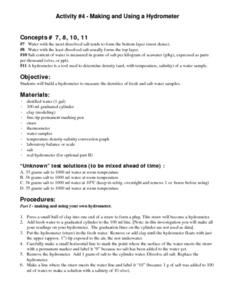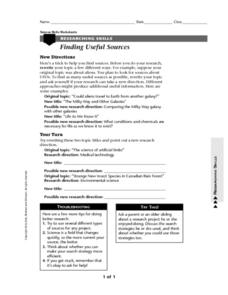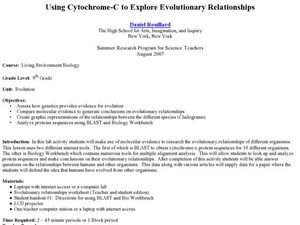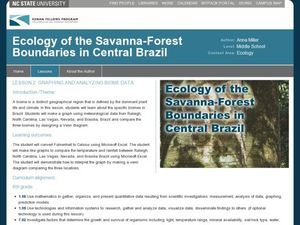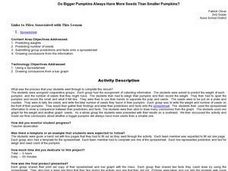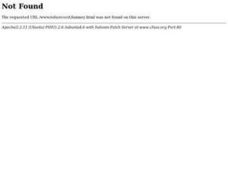Curated OER
HOW FAST DO SEDIMENT GRAINS OF DIFFERENT SIZES SETTLE?
Students conduct an experiment using sand, a jar, and a paper clip to analyze the effects of different kinds of sand vis a vis its sediment. They graph their findings and analyze for factors of size, shape, and density.
Curated OER
Making and Using a Hydrometer
Students build a hydrometer to measure the densities of fresh and salt water samples. They record the water temperature and density and use the temperature, density, and salinity conversion graph to locate the salinity. Finally,...
Curated OER
Finding Useful Sources
In this finding useful sources worksheet, students read about how to approach writing topics for their research. Students are given topic titles and they come up with new titles and a new direction for the research topics given.
Curated OER
Using Cytochrome-C to Explore Evolutionary Relationships
Students analyze protein sequences. In this lesson on determining evolutionary relationships, students use the Internet tools BLAST and Biology Workbench to look at protein sequences. Students will compose an essay that includes their...
Curated OER
Teaching the Scientific Method Using Adhesives
Students research on the history of adhesives. In this science lesson, students select one test to use in finding the stickiness of adhesives. They collect data and formulate a conclusion.
Curated OER
Plants and Animals Depend Upon One Another
First graders study plants and animals and how they depend on one another. They also study that plants give energy to animals and provide oxygen needed for life. Finally, 1st graders give examples of the roles plants and animals play...
Curated OER
Using the Clinometer
For this clinometer worksheet, students measure the altitude of ten objects using a clinometer. They answer questions about calibrating a clinometer and measuring with a clinometer.
Curated OER
Comparing Microscopic Organisms in Fresh and Polluted Water: An Invitation To Inquiry
Students have the opportunity to develop and formulate ideas and explanations through the scientific standard of inquiry. They identify organisms by using an identification key for specific aquatic geographical area.
Smithsonian Institution
Water/Ways: The Poetry of Science
Water is the source of life. It appears in poetry in both peaceful and torrential descriptions; it appears in earth science in its liquid, gaseous, and solid states. Combine these interpretations of our planet's most precious and...
Curated OER
Graphing and Analyzing Biome Data
Students explore biome data. In this world geography and weather data analysis lesson plan, students record data about weather conditions in North Carolina, Las Vegas, and Brazil. Students convert Fahrenheit degrees to Celsius degrees...
Curated OER
Fall vs. Spring
Students compare fall and spring. In this seasonal changes lesson, students read the book Apples and Pumpkins and discuss the fall season. The students then read It's Spring and describe the spring season. As a culminating activity,...
Curated OER
Milkweed and Monarch Butterfly Mania
In this online/interactive worksheet comparing and contrasting Monarch and Great Spangled Fritillary Butterflies worksheet, students read an online comparison and contrast guide, use the graphic organizer, and record the similarities and...
Curated OER
How to Make Invisible Ink
Young scholars learn how to make two types of invisible ink. In this invisible ink lesson plan, students will make two types of invisible ink using common house hold items. They will then write a paper comparing and contrasting each type...
Curated OER
Plant Growth - Light and Shade
Third graders conduct an experiment comparing plants. In this plant lesson, 3rd graders plant seeds and grow two varieties of plant comparing the light needed for it to grow. Students make predictions and record their observations....
Curated OER
Magnets in a Bag
Fifth graders compare and contrast the patterns that they create using iron fillings and different types of magnets.
Curated OER
Water Treatment Plant
Second graders create their own water treatment system. In this water treatment activity, 2nd graders create the water treatment system and record how it works. Students list materials they used and write about what they saw. Students...
Curated OER
Do Bigger Pumpkins Always Have More Seeds Than Smaller Pumpkins?
Second graders, in groups, predict the weight of a pumpkin and the number of seeds it might have. Then they find and record the actual weight and actual number of seeds. They compare and contrast the size of the pumpkin to the number of...
Curated OER
Bread Cells
Fifth graders examine plant and animal cells. For this plant and animal cell lesson, 5th graders define what cells are, label their parts, and describe how plant and animal cells are different. They observe cells at a number of web...
Curated OER
Fishes and Amphibians
In this fish and amphibian characteristics learning exercise, students will two idea maps to compare fishes and amphibians. Students will complete 2 short answer questions based on these idea maps.
Curated OER
Reflections Of
Students create angles using mirrors. In this angle reflection lesson, students draw angles, then use mirrors to create angles using reflections and measure the new angles.
Curated OER
Comparing Volumes
Learners conduct experiments to discover the various ratios of oil to popcorn kernels. They determine which amount of oil produced the most popped kernels.
Curated OER
Land Use Issues
Learners examine soil types and determine the ability of each to absorb water. Working in groups, they time how long it takes for water to seep out the bottom of the cups. They examine soil components, conservation, erosion, and tree...
Concord Consortium
Molecular View of a Solid
Why are solids, well ... solid? Take a peek inside a solid substance with an easy-to-use interactive. Science sleuths examine the motion and position of the atoms that make up a solid before drawing conclusions from their observations.
Curated OER
Mineral Matters
Middle schoolers work in a team to use the ProScope Digital USB Microscope and a computer to collect microscopic images from a variety of mineral specimens. They compare specimens and determine how they are alike and different by...



